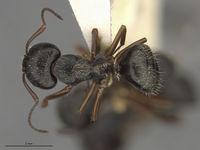Camponotus altivagans
| Camponotus altivagans | |
|---|---|

| |
| Scientific classification | |
| Kingdom: | Animalia |
| Phylum: | Arthropoda |
| Class: | Insecta |
| Order: | Hymenoptera |
| Family: | Formicidae |
| Subfamily: | Formicinae |
| Tribe: | Camponotini |
| Genus: | Camponotus |
| Species: | C. altivagans |
| Binomial name | |
| Camponotus altivagans Wheeler, W.M., 1936 | |
Camponotus altivagans is known only from type material.
Identification
Distribution
Latitudinal Distribution Pattern
Latitudinal Range: 18.36° to 18.36°.
| North Temperate |
North Subtropical |
Tropical | South Subtropical |
South Temperate |
- Source: AntMaps
Distribution based on Regional Taxon Lists
Neotropical Region: Greater Antilles, Haiti (type locality).
Distribution based on AntMaps
Distribution based on AntWeb specimens
Check data from AntWeb
Countries Occupied
| Number of countries occupied by this species based on AntWiki Regional Taxon Lists. In general, fewer countries occupied indicates a narrower range, while more countries indicates a more widespread species. |

|
Estimated Abundance
| Relative abundance based on number of AntMaps records per species (this species within the purple bar). Fewer records (to the left) indicates a less abundant/encountered species while more records (to the right) indicates more abundant/encountered species. |

|
Biology
Castes
Worker
   
| |
| . | |
Nomenclature
The following information is derived from Barry Bolton's Online Catalogue of the Ants of the World.
- altivagans. Camponotus (Myrmeurynota) altivagans Wheeler, W.M. 1936b: 207 (s.w.) HAITI.
- Type-material: 3 syntype major workers, 3 syntype minor workers.
- Type-locality: Haiti: between La Visite and Kenscoff, 1934 (P.J. Darlington).
- Type-depository: MCZC.
- Status as species: Kempf, 1972a: 49; Bolton, 1995b: 85; Lubertazzi, 2019: 81.
- Distribution: Haiti.
Unless otherwise noted the text for the remainder of this section is reported from the publication that includes the original description.
Description
Worker
Major
Length 5.5 -6.5 mm.
Head trapezoidal, as broad as long, with straight posterior border and feebly convex, anteriorly converging sides. Eyes moderately large, at the posterior third of the head, without clearly developed ridges between the posterior orbits and posterior corners. Mandibles stout and convex, apparently 5-toothed, the apical tooth longer and stouter than the four subequal, narrow basal teeth. Clypeus trapezoidal, as long as broad, carinate basally, the anterior border broadly rounded in the middle and deeply sinuate on each side. Frontal area distinct, transversely triangular; frontal carinae anteriorly approximated, widely diverging behind; frontal groove distinct. Antennae slender; scapes curved at base, distinctly thickened distally, extending about twofifths their length beyond the posterior border of the head. Thorax in profile evenly but not very convexly arcuate as far as the posterior end of the base of the epinotum, where it rounds into the rather steeply sloping declivity, which is of the same length as the base. Promesonotal suture impressed; mesoepinotal suture indistinct. From above the pronotum is flattened, nearly as long as broad, produced in the middle anteriorly, the sides rounded, marginate anteriorly at the humeri and halfway back to the promesonotal suture, the anterior and inferoanterior border of the pronotum developed as a narrow sub transparent lamella. Mesonotum also somewhat flattened above, slightly broader than long, sub trapezoidal, its sides rounded and converging posteriorly. Petiolar scale inclined forward, oval, rather thick, with convex anterior and flattened posterior surface and rather blunt superior border. Gaster broadly elliptical, the first segment flatly truncated anteriorly. Legs stout; fore femora enlarged.
Subopaque; gula, posterior corners of head, venter and legs more shining. Mandibles finely shagreened and coarsely and sparsely punctate. Head, thorax and petiole densely and finely punctate or sharply reticulate, with coarse, scattered, piligerous punctures, which are lacking on the sides of the thorax, where the sculpture becomes more punctulate-striolate. Gaster above very finely, sharply and transversely striolate-reticulate, with sparse, coarse, transverse, piligerous punctures. Venter smoother; scapes more sharply, legs more superficially shagreened.
Pilosity consisting of flattened or scalelike hairs, partly white, erect, longest on the epinotum, border of petiolar scale and dorsal surface of gaster and short on the head and clypeus, and partly yellowish and appressed, directed forward on the head and thorax and backward on the gaster. Pilosity on legs simple, very sparse, short and appressed, except for a row of long hairs on the flexor surfaces of the femora and a few bristle-like hairs at their tips.
Black; mandibles, except their teeth, scapes and base of petiole red; funiculi fuscous; posterior borders of gastric segments sordid yellowish; legs reddish testaceous, tarsi darker red.
Minor
Length 4 mm.
Differing from the major in the following characters: Pronotum proportionally broader, less produced anteriorly in the middle, its sides sharply marginate or sublaminate throughout; epinotum more strongly narrowed behind and in profile distinctly angular, the declivity longer than the base, more abrupt and decidedly concave. Appressed flattened hairs as numerous and as long on the head as on the thorax and gaster, but absent on the sides as they are on the pleurae. Sides and posterior corners of head reddish; whole petiole red or testaceous; scapes as pale as the legs.
Type Locality Information
Described from three major and three minor workers taken by Dr. Darlington between La Visite and Kenscoff.
References
- Lubertazzi, D. 2019. The ants of Hispaniola. Bulletin of the Museum of Comparative Zoology, 162(2), 59-210 (doi:10.3099/mcz-43.1).
- Wheeler, W. M. 1936c. Ants from Hispaniola and Mona Island. Bulletin of the Museum of Comparative Zoology 80: 195-211 (page 207, soldier, worker described)
References based on Global Ant Biodiversity Informatics
- Kempf, W.W. 1972. Catalago abreviado das formigas da regiao Neotropical (Hym. Formicidae) Studia Entomologica 15(1-4).
- Perez-Gelabert D. E. 2008. Arthropods of Hispaniola (Dominican Republic and Haiti): A checklist and bibliography. Zootaxa 1831:1-530.
- Wheeler, William Morton. 1936. Ants From Hispaniola and Mona Island. Bulletin: Museum of Comparative Zoology at Harvard College. 80(2):192-211.

